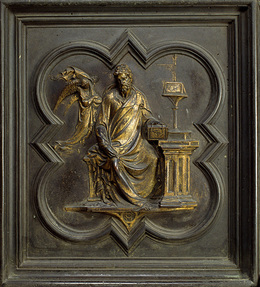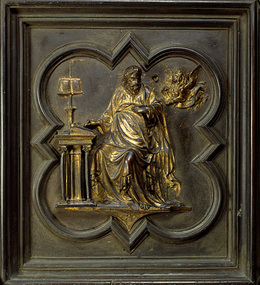Panel XXIII- Luke
Panel details:
Luke 1:1-4: inasmuch as many have taken in hand to set in order a narrative of those things which have been fulfilled among us, just as those who from the beginning were eyewitnesses and ministers of the word delivered them to us, it seemed good to me also, having had perfect understanding of all things from the very first, to write to you an orderly account, most excellent Theophilus, that you may know the certainty of those things in which you were instructed.
Luke was born in Antioch in Syria around 10 ad into a pagan Syrian family. His name, Luke, is probably an abbreviation of Lucan. He was raised a pagan, and only later became a proselyte or at least a sympathizer of the Jewish religion. He was not a disciple of Jesus of Nazareth and neither does he appear as one of the first seventy disciples, as he converted at a later date, becoming a member of the Christian community of Antioch probably around the year 40 AD. Luke accompanied st. Paul during his second missionary journey, starting in Antioch around 50 AD for about 4-5 years, preaching in what are today Turkey and Greece, as well as in his third missionary journey (around 54-58 AD again in Turkey and Greece) ending in Jerusalem, where Paul was arrested towards 57-58 AD and held prisoner at Caesarea. Luke’s narrative in the first person suggests he was together with Paul during the journey to Rome waiting to be judged by the emperor and where he remained in a sort of house arrest for two years. Luke was Paul’s disciple and shared the Pauline vision of the new universal religion; thus, when he decided to write his own works, he wrote especially for the communities that had been evangelized by Paul, as well as for all those converted from paganism. Luke also encountered st. Peter, st. James the Lesser, leader of the church of Jerusalem as well as st. Barnabas with whom he had a longer relationship, and perhaps st Mark. Luke was a disciple of the apostles; Paul mentions him in several of his letters, referring to him as “fellow worker” in the letter to Philemon, 24 and defines him the “beloved physician” in the letter to the Colossians (4:14).
When Paul was in prison, awaiting punishment, he wrote to Timothy: (4,11) “for I am already being poured out as a drink offering, and the time of my departure has come. Make every effort to come to me soon for demas...has deserted me.... crescens has gone to Galatia, Titus to Dalmatia. Only Luke is with me. Take Mark, and bring him with thee: for he is profitable to me for the ministry.... “. This is the last reliable script we have concerning the evangelist. Luke continued the missionary journeys and evangelized Macedonia, Dalmatia, Italy and Gaul. While st. Paul was imprisoned in Rome, Luke wrote the “Acts of the Apostles” in which he narrates the early years of the Church and in particular the travels of st. Paul.
Luke studied medicine and travelled often to Greece and Egypt to perfect his knowledge of this science, practicing the profession of physician in Troas. According to scholars, the qualification of physician attributed to Luke is confirmed by the stylistic analysis of his works. He only uses specific terms: for instance, he writes about the “high fever” Püretò Megàlo) that Peter’s mother-in- law had suffered (Luke 4:38); and he speaks of dropsy by mentioning a person with dropsy, üdropikòs, a person who presented an amassing of abnormal serum in an organ, perhaps in the abdomen (Luke 14:2). He narrates that Jesus “being in agony, prayed more earnestly”; and “his sweat became like great drops of blood” (Thròmboi Aimatos), more properly, “drops of blood” (Luke 22:44); today, a colleague of Luke would diagnose the phenomenon, “ematidrosi”. He uses the word “vertigo”, in Luke 21:34: “... your hearts be weighed down with carousing, drunkenness, and cares of this life...”, where the word rendered “drunk” is not exactly drunkenness, rather “vertigo” (krepàle), in the Greek version and it is not intended as “debauched drinking”, rather the dizziness as a result of drunkenness or: “that your hearts do not escalate due to dizziness and drunkenness (krepàle), abusing of wine and concerned for living”; or further, to use contemporary language: do not damage your hearts with the fumes of alcohol and alcohol abuse, believing this will alleviate the anxieties of life.
Ancient tradition that acknowledges Luke a painter and the founder of Christian artistic tradition lies within the context of the iconoclastic controversy (730- 843), as a comprehensive study of ancient traditions substantiated the belief of the apostolic origin of utilising sacred effigies. The studies were about personages who painted portraits of the principle figures surrounding Jesus during his lifetime, preserving the memory of their earthly aspect. In regard to Luke the painter, the profession of medical doctor implied that he had familiarity with painting, since late antique tradition deemed it an essential tool in order to correctly illustrate medicinal plants as well as the human body. Artists were required to have some knowledge of botany to be able to produce colours. The earliest evidence of the legend is the treatise on the holy images by Andrew of Crete (eighth century), in which the author declares the unequivocal accuracy of the portraits painted by Luke. Thomas Aquinas, eminent father of the Church, in referring to John of Damascus’ theoretical elements, affirming the need to respect the venerable traditions performing and honouring sacred images, officially consecrated Luke the painter of sacred images. There is actually no historical basis to confirm the legend that Luke was the painter of sacred images, and especially of the Madonna. However, legends often conceal a truth, which in this case is that Luke indeed did leave us the “portrait of Mary”; furthermore, his gospel is the one that more than any other has inspired great artists. Luke’s expertise and specific preparation were certainly well known among the communities he belonged to. It is possible that he even took care of the mother of the Lord and therefore gathered information from Mary about Jesus as a child. Luke was, in truth, the only evangelist who wrote accurate information about the Virgin Mary and the childhood of Jesus. What is certain is that his general knowledge and experience of mankind were quite remarkable. The proof is in his literary style, his fluent and elegant use of the Greek language, and the very structure of his writings as well as his excellent knowledge of the bible written in Greek, called “septuagint” and lastly, the points of correlation with the writings of the Greek historians of his time (particularly, his ability to build credible, compelling and diversified speech in the mouths of many people, specifically in the acts). Luke wrote his gospel between 70-80 aC. It is the longest of the four evangelists’, containing 19.404 words, the richest vocabulary, (Luke used 2.055 different terms) and is more refined from a stylistic point of view. He dedicated his work to a certain Theophilus (probably a prominent Christian figure or perhaps since in the prologue Luke apostrophized him as “most excellent”, presumably a person in the imperial court); therefore, Luke followed the practice of the classical writers who dedicated their works to illustrious personalities. A further theory is that he intended to devote his gospel to those who love God (Theophilus, signifies a lover of God). Whether the dedication is to a real person or otherwise, from a literary point of view, it is not important; the dedication most notably testifies the author’s inclination, more so than the other evangelists, to compose a literary and historical work, as are his efforts to place the events narrated in chronological order. The historiographical context of Luke’s gospel demonstrates a qualitative leap in style compared to mark’s work. The gospel of Luke is almost twice as long as that of Mark. Luke added considerably more material in the course of his narration: he narrated many of the teachings of Jesus, but also accounts of miracles that are not in Mark’s gospel. Experts on Luke now unanimously agree that the author of the gospel also wrote the Acts of the Apostles. The gospel and the acts, it is often said, are the two parts of a single volume, the two panels of a diptych, called synthetically “by Luke”. The reasons for this are literary. Luke knew and applied the rule that those who write a two-volume work (or a volume in several parts) must write a brief summary of the first part at the beginning of the second, in few lines, linking the two parts. Further, the first verses of acts (1:1-11) refer to the prologue of the gospel (Luke 1:1-4) briefly repeating the events narrated in the last chapter (Luke 24). There is a third fact that is even more important and it is the narrative. In the first stage of the narrative Luke made some promises that are not fulfilled in the gospel. To explain this more precisely, it is said that Jesus is the light of God’s revelation to the gentiles (cf. Luke 2:32), that he is not only the saviour of Israel, but of all the peoples of the earth. Therefore, if we remain within the confines of the gospel, this is not accomplished. one must read and understand the book of acts, when Paul in Rome finally can say that God’s salvation has been brought to the people and they received it (acts 28.28). Luke’s theological project would have remained unfinished without the acts of the apostles. It is necessary to understand the fundamental dynamics set in motion by Luke who had written an “unfinished” gospel, which was meant to move us beyond the last page. to express this concept in a more polite way, Luke invites us to open the second book, upon finishing the first.
Luke allegedly died in Bithynia at the age of 84 and was buried in the city of Thebes. His bones were transported from there to Constantinople some time after the middle of the fourth century and in the same century or possibly the eighth century, transported to Padua to the abbey of st Justine. Benedictine monks who settled in Padua before 1000 began to venerate the relics of the evangelist. In 1354, emperor Charles IV of Luxembourg, king of Bohemia, had the skull brought to the Cathedral of st. Vitus in Prague where it remains today. In 1436, the painter Giovanni Storlato was commissioned to represent on the walls of the chapel dedicated to the saint, in the Abbey of st Justine, a series of scenes narrating the life of st Luke, the transferral of the relics from the east and their recovery in Padua. a century later, in 1562, the marble sarcophagus of the relics was moved to the north transept. The bishop of Padua appointed a commission of experts to conduct a scientific survey of the relics of st. Luke for the great Jubilee of 2000. On 17 September 1998 the lead-sealed coffin was opened and a human skeleton in good condition was found therein. The final results of the survey were presented at the international conference, held in Padua in October 2000. The scientific data, as stated during the conference, did not disprove the traditional attribution of the remains to st. Luke. rather, the data was precise and complementary to written sources, enabling historical investigations especially to clarify how, when and why the body was transferred from Constantinople to Padua. According to st. Jerome and bishop Victorinus (died 303), st Luke’s symbol is the winged bull, because the first person he introduces in his gospel is the father of John the Baptist, Zechariah, a temple priest and head of the sacrifice of bulls. The Catholic Church and the Orthodox Church revere Luke as a saint. The universal church celebrates his feast day on 18 October. Dante described st Luke the “scribe of the gentleness of Christ” due to the predominance, in his gospel, of images of meekness, joy and love. st. Luke the evangelist is considered the patron saint of physicians, sculptors, artists, painters and surgeons.
The iconography of the evangelist saint is depicted in three manners: physician, painter and evangelist with the symbol of the bull. The evangelist has been venerated since apostolic times. One of the oldest paintings of st. Luke has been found in Rome in the catacombs of Commodilla where the saint is depicted with his bag of medical instruments, suggesting that devotion to Luke was connected to the miraculous aspect as in Rome the oriental medical saints, Cosmas and Damian, were worshipped in the basilica that pope Felix dedicated to them in 526.
The various portrayals of st. Luke reflect the iconography mentioned above. Regarding st Luke the “painter”, there are images of ancient tradition and some of the icons of the Holy Mother, venerated by the Church, are attributed to Luke. Many black Madonnas are attributed to st Luke, such as the famous Odighitria and Czestochowa as well as all of the others in Rome, Jerusalem, Madrid, Malta, Freising (Bavaria), Bologna, Bari, etc., though no historical or artistic source is available to prove this. one of the interpretations claiming that st. Luke was also a painter refers to some words in his gospel spoken by Simeon during the presentation in the temple, who prophesies the passion, saying: “... Mary...a sword shall pierce through your own soul also” (Luke 2, 35). The black faces of the “Madonnas of st Luke” symbolically indicate that they are “sorrowful Madonnas”. Alternatively, attributing these depictions to the evangelist may have been a way to demonstrate his loyalty as well as the antiquity of the image.
St Luke is portrayed in codexes and medieval illuminated gospels, as are all the other evangelists. At that time, it was essential to evoke the image and the symbol so as to reinforce the text.
Lorenzo Ghiberti created the panel depicting st Luke on the North Door of the Baptistery in Florence between 1403-15. The panel belongs to the first phase of his work, which still reflects the influence of late Gothic style. The Gothic-international influence is evidenced in the accented decorations of the figures, the draperies and in the rhythm of the composition that describes the scene. Ghiberti conformed to the international Gothic style, while at the same time he introduced spatial perspective innovations of the early Renaissance style. The other panels created in the early stages of the work, together with the evangelists, include agony in the garden, Jesus among the doctors, temptation of Christ, transfiguration, crucifixion, the last supper and the figures of the fathers of the church.
The figure of the saint is perfectly centred and inscribed in the quatrefoil frame and portrayed seated, with the lectern to his left in perspective, clearly denoting the furnishings in churches of the period. The evangelist is depicted at an elderly age with a beard and long hair falling to his shoulders. He is portrayed in profile while the natural gesture of his crossed right leg breaks the static setting of the composition. the flexibility of the sculpture describing a dynamic curved shape created by the elegant drapery completed with delicate decorations covering his limbs and the bench is in Gothic style. St Luke‘s right hand is resting on the leg that holds an opened scroll, while his left hand is extended over an open book resting on the lectern. The body of the saint is obliquely shaped while his arm and his right leg in the foreground are natural and lifelike, in the early Renaissance style. The figure of the bull emerging from behind the lectern moves his head timidly toward the saint. The composition depicts a balance of shapes and movements that is logical as the scene is focused on Luke concentrating on writing the gospel, whilst the bull benevolently gazes at him.



